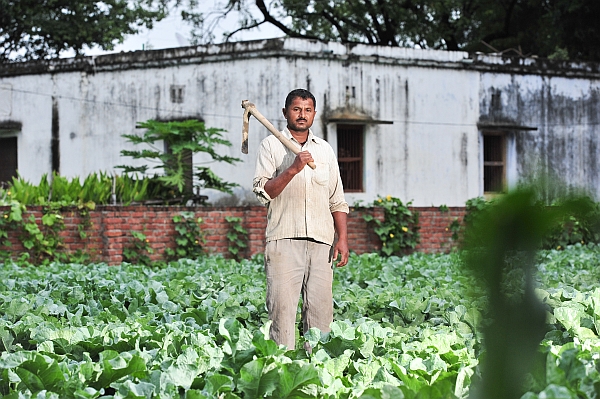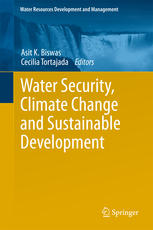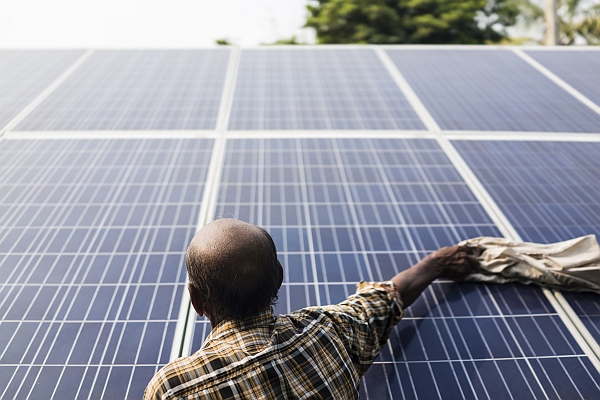Innovation in water-use can build community resilience
One of the positive outcomes of the recent UN climate summit in Paris, was the increased commitment by emerging economies to reduce their greenhouse gas emissions. Nowhere is this more vital than in India, where the demand for energy is escalating as the economy surges on.

Photo: Neil Palmer / IWMI
India’s poorest are likely to be among those most affected by a changing climate, so a new approach to mitigation makes sense. But change itself is now inescapable – indeed many would argue that more erratic weather patterns are already evident across the sub-continent.
[pullquote type=”pullquote3″ align=”right” content=”In a changing climate, storing water underground makes sense” quote_icon=”yes” textcolor=”#3c7746″]In a changing climate, storing water underground makes sense[/pullquote]
Increasing climate variability makes it harder for India’s 100 million farmers to plan effectively. Critical to this uncertainly is access to water. This new reality challenges conventional approaches to resource management and will require the development of alternative ideas.
 As part of this ongoing dialogue, a group of leading IWMI scientists have written an overview of innovation in Indian agricultural water management which appears as a chapter in a newly published book, Water Security, Climate Change and Sustainable Development.
As part of this ongoing dialogue, a group of leading IWMI scientists have written an overview of innovation in Indian agricultural water management which appears as a chapter in a newly published book, Water Security, Climate Change and Sustainable Development.
The chapter Adapting to Climate Change and Variability in India is wide-ranging, but identifies some key areas where urgent attention is needed…and prominent among these is groundwater.
Even before climate change became headline news, parts of India had been experiencing groundwater depletion for many years. To support the Green Revolution, India’s farmers had drilled and pumped many aquifers far beyond their capacity to recharge. Food production boomed, but inevitably the level of water tables fell, requiring deeper wells and yet more energy to pump.
But rather than viewing this as an excuse to restrict groundwater access, the IWMI team see sustainable underground storage as a clear opportunity for India to increase its climate resilience.
“In a changing climate, storing water underground makes sense,” says IWMI’s Jeremy Bird, one of the authors. Evaporation is reduced, and no land is lost to ponds or reservoirs. What we need is a smarter approach to groundwater management that uses the latest technology to capture water and then measure, monitor and incentivize its sustainable use
A crucial part of this is to make sure that when there is excessive water, as much of it as possible ends up below the surface. By proactively “taming” floods underground, aquifers can be recharged to provide a storage buffer that farmers can use. IWMI has already initiated a pilot scheme in Uttar Pradesh to test the concept.
In many parts of India, however, there is no shortage of groundwater. This is particularly true in the Eastern Gangetic plain, where there is scope for further development of the resource. In this region, lack of power for pumps remains the critical issue for many famers. New energy sources, like solar photovoltaic panels, could make a huge difference. These have the added advantage of being emission free at point of use, thus helping to cap greenhouse gas releases.

Photo: Prashanth Vishwanathan / IWMI
But the authors urge caution: this climate mitigation solution comes with a major risk if not carefully managed. The low running cost of solar energy units further threatens the sustainability of groundwater levels, and this is a fast-emerging ‘nexus’ issue at the interface of water, food, energy and the environment. Work being undertaken by IWMI, under the IWMI-Tata Water Policy Research Program, shows that with the right incentives to buy back excess electricity from these pumps, either individually or through a solar power cooperative, irrigation can kept sustainable, whilst producing a “solar crop” of electricity which benefits both the farmer and national economy.
A further example where new technology is proving a game-changer is in data collection and management. More sophisticated and accessible satellite remote-sensing data provides new opportunities for planning, management and emergency response during extreme climate events. For instance, real-time drought monitoring technology, such as the South Asia Drought Monitoring System in which IWMI is a partner, can help farmers make more effective decisions on crop selection and water management. This can be easily communicated to individuals by mobile phone, and locally tailored down to field level, based on advanced high-resolution imaging.
The impacts of excessive water can also be better managed by analyzing historic flood events. Computer modelling allows researchers to better assess future risks. This information can be used, for instance, to design crop insurance packages for smallholder farmers. Satellite sensing can also help administer such systems since an “eye in the sky” can easily record which fields are flooded, how deep the water is and how long the inundation lasts. This can then trigger payouts to affected farmers who would otherwise find it hard to prove that they had lost out. Rapid analysis of ongoing extreme flow events can also help direct emergency relief efforts.
The authors emphasize that no single solution will deliver climate resilience for rural India. At the community level, a broader awareness of resilience is being promoted through the Climate Smart Village initiative, led by the CGIAR Research Program on Climate Change and Food Security. This takes a comprehensive approach to improving a community’s ability to deal with extreme events. Under the initiative, and in partnership with local organizations, researchers can recommend a range of institutional and technological approaches that can be focused on both adaptation and mitigation. This can be linked to existing development initiatives both at farm level, or more broadly – such as the creation of seed banks for climate-resilient crop varieties.
“There is a real need for cross-sectoral cooperation and multi-scale initiatives,” says Bird. “This has often been elusive in previous rural development programs, but we hope that the risks that climate change poses will galvanize the various agencies into action and foster exciting new partnerships.”
This research is supported by the CGIAR Research Programs on:

